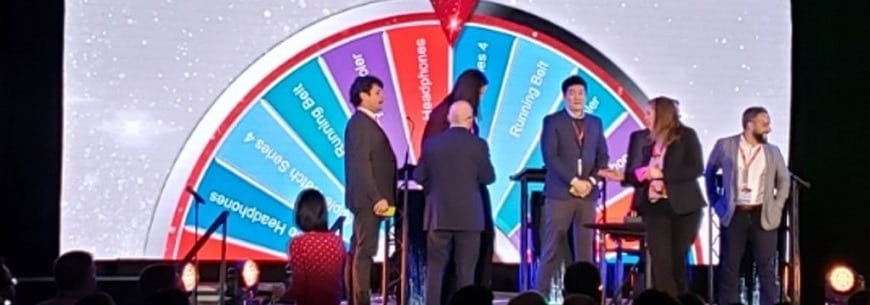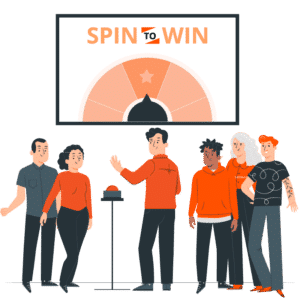13 Audience Participation Games for Corporate Events
When it comes to audience participation games, these are some of the questions that our potential clients bring to us in our first meetings. Ultimately, they are searching for the best game for their needs:
- What are some simple and fun, games for audience participation?
- How can you create audience participation games that are relevant to your content?
- How can you create audience participation games that keep attendees engaged over multiple days of your corporate event?
- If you are a speaker (or facilitator) trying to spice up your session, how can you implement these games yourself?
- How can I use the data collected to make better business decisions?
- What should I keep in mind when creating a game?
- Create a simple game title or theme
- Game rewards
- What common mistakes should I avoid?
To help you with your brainstorming, we pulled together a list of audience participation games and provided a short explanation of how they could work inside your event. Use this list as one input for your own sales meetings, customer events, and conferences. We grouped the games into three different game families:
I promise you will not like all of these ideas. Some will not be a good fit for your audience or event. On the other hand, I promise that this list will help your team start the brainstorming process to more easily identify the experience that you want to create for your event.
Interactive Trivia Games
Many people are familiar with trivia games, because they have either used them with their audience response software, played HQ or Trivia Crack on their phones, or have watched some of these games on TV.
Here are seven different trivia games that could work for your next event:
1. Live Trivia in General Session
(Players can play online, in webex, zoom meetings or in virtual events)
If your general session needs a spark of energy, perhaps you should consider Live Trivia. It’s a great 10-20 minute activity that will shake things up and help you deliver content in a fun way.
Attendees would open the trivia game on their phone (could be inside the event app or stand-alone). The Emcee will push questions to the attendee’s phones and the big screen. Once the question is closed, players will see if they got the question right or wrong. The big screen will show the correct answer and how players responded. The winner will be the top players or teams on the leaderboard.
Team Battle: If your audience naturally forms into teams, you can create a team battle to see which teams earn the most points. The Leaderboard will allow you to rank the teams.
2. Elimination Game or Last Person Standing
(Players can play online, in webex, zoom meetings or in virtual events)
Another strategy is to use an elimination game or survivor trivia to see who is the last person standing. It’s a way to boost the energy in the room and recognize awesomeness.
Similar to the popular trivia game HQ, players answer questions until they get one question wrong. This game style works because everyone thinks they are smarter than the person next to them. You can use the leaderboard to show the number of people who are remaining in the contest until you get down to the last 10-20 people left in the game. Then, the leaderboard switches to showing the names of the final players remaining. The list will get shorter until you identify a winner.
In the previous game format, players may answer many questions, make mistakes, and play again. In the elimination format, the player’s turn will end after one false move.
3. Trivia Game with Cumulative Leaderboard
(Players can play online, in webex, zoom meetings. Good option for multi-day virtual events)
An alternative to the single trivia game (option #1 above) encompassing all learning objectives, is a series of smaller games (or quizzes). Then, use the leaderboard to add up the scores from all of the games.
There are several advantages to this game format. One advantage of this type of game is that it’s easy to relate the content to the session that just completed. Another advantage is that you can set up different gameplay rules for the content. For example, you may want sales reps to take the quiz on IT safety standards just once (and then you show them the correct answers) – while the game on selling skills could be played 3-5 times (while the correct answers remain hidden).
If you have the time and energy to set up your game this way, it could generate a massive payoff for you.
(Learn More or Play Now)
4. Trivia Bar on the Show Floor
Think about this format as a sponsorship benefit or a sponsorship experience. You are going to drive traffic to the trade show floor and use content from exhibitors to populate the trivia game. So, even if players don’t visit all the booths, they get exposed to the sponsors’ key marketing messages.
The game works like this: Setup a leaderboard on a large monitor behind a 6-foot bar or a horseshoe-shaped bar. Then put multiple iPads on tabletop stands. Players will walk up and start playing the trivia game, and a small crowd will form.
When you use a trivia bar, you create an entertaining physical space where attendees play shoulder to shoulder. Plus, you create a new sponsor benefit for exhibitors.
We have seen this pattern used in Customer Events, Sales Meetings, and Association events. The goals are always the same: (1) Drive people to the trade show (or resource fair) floor and (2) Educate attendees on sponsors’ content at the same time.
At the end of the event you can give the sponsors game metrics such as unique game players, the number of games played and performance data such as the number of trivia questions answered about the sponsor and how attendees answered the questions.
(Learn More or See Examples)
5. Countdown Trivia Game
If you have ever played bar trivia, the countdown trivia game might be familiar to you. You give attendees 12 – 20 seconds to answer trivia questions. The faster the player answer the question, the more points they earn. However, the points will decrease as the time ticks off the clock. So, players need to think and act quickly to do well in this game.
This game rewards your sharpest attendees and game players. Use this type of gameplay at the end of a conference, instead of a test or quiz. It can be an energizing experience for your attendees to see how much they know.
(Learn More or Play Now )
6. First To The Finish Line
This type of trivia game uses graphics to show player’s progress toward the finish line instead of a traditional points leaderboard. The graphics could be of race cars, horses, and more – that are racing to the finish line. As players (or teams) answer the questions correctly, their vehicle (or another themed character) moves forward. The winner is the first player (or team) to make it across the finish line. This game format requires an emcee or host to drive the game. All players are answering the same questions at the same time. We like this game format for two reasons. First, the game format can easily tie into your event theme. Second, it’s a way to incorporate team gameplay.
7. Quizzes
(Players can play online, in webex, zoom meetings. Good option for multi-day virtual events)
Quizzes, well, I hope you are familiar with a quiz. Create a quiz as either a pre-test or a post-test on the content you are presenting. This format is suitable for self-assessment. Some players will be motivated by social recognition (leaderboards) and other by rewards (prizes).
If you are doing more than one quiz, you should consider rolling them together into a interactive trivia game with a cumulative leaderboard (like option #3).
Challenge (or Activity-Based) Games
In this category of games, players earn points for completing challenges and activities. They earn drawing entries, prize wheel spins, instant prizes, or status on the leaderboard.
Here are three different challenge or activity-based type games that you can create:
8. Event Gamification
(Good option for multi-day event gamification.)
These activity-based games allow you to design your activities and rewards around your event objectives. For example, you can combine a building scavenger hunt with a trade show passport game and a series of knowledge check quizzes to create maximum engagement.
Another advantage of this game format is that players can participate in real-time during a session, in the app, or by scanning QR codes in physical space. This flexibility allows you to be creative in how you want to design your game.
Depending on the game platform, there may be multiple reward and recognition systems – such as earning prize wheel spins, a spot on the leaderboard, entries into a drawing and more.
This flexibility allows the platform to work for Sales Kick-off Meetings, Customer Events, Exhibitor Booth Passport Games, Leadership Conferences and more.
(Learn More or Try our Exhibitor Booth Passport Game or Try our Sales Kickoff Game)
9. Digital Trade Show Passport
The trade show passport game is a commonly used game to drive attendees to the trade show floor to visit the exhibitors’ booths. Usually, players receive a card or booklet – like a passport. Exhibitors stamp the passports of each player who visits. Players who stop at all of the booths earn an entry into a grand prize drawing.
Digital versions of the game allow gameplay on your phone or by scanning QR codes. Completing challenges could involve getting a code from a booth staffer, watching a demo, stumping the expert or answering the question of the day. SocialPoint’s digital version of the game offers rewards such as a raffle wheel drawing or earning free spins of the virtual prize wheel.
(Learn More or Play Now)
10. Scavenger Hunt
Scavenger hunts are typically photo-based gamification used for team building and collaboration. Small groups are organized into teams and sent on an adventure to find a bunch of artifacts or complete a series of challenges. The goal is to get small groups talking and working together.
The digital version of these games allows clients to replay the highlights from the event by showing the photos captured on a photo wall at the end of the event.
(Learn More or Try our New Employee Orientation Scavenger Hunt Game)
Spin-to-Win Games
Spin-to-win energizes your prize draw or drawing a name from a hat. Instead of pulling a name blindly, the spin-to-win animation adds excitement and hope to the game.
Here are three different spin-to-win games that you can create:
11. Prize Drawings
When clients have 5 to 12 prizes to giveaway – clients will use spin-to-win to pick the prize. The wheel adds an element of excitement to the giveaway process. Players see all of the prizes going past. It’s fun for everyone.
12. Name Wheel
Put the attendees (or the qualified attendees) on the name wheel. Then spin the wheel to see whose name will be selected. Attendees love watching the names slow down, hoping the wheel stops on their name.
13. Golden Ticket
Tape a few Golden Tickets under the seats in your general session. Then, ask people to check to see if they are sitting in the location of a golden ticket. Bring the ticket holders on stage to spin the virtual prize wheel to see what prize they have won. Some clients will allow people to spin the wheel a second time to see if they can win a better reward. Beware – the second spin could give them a less desirable prize than the first spin!
Final Thoughts
As you can see, there are many ways to build Audience Participation Games for your event. Your success will come from your ability to choose the right game (or games) for your audience and event objectives. Not all games are right for every audience or event situation.
I wish you the best of luck with your next event game.
If you’d like to learn how you can keep more of your attendees engaged in your event content throughout your entire sales or customer meeting, click to read more about our solutions for Virtual Trivia, Scavenger Hunts, QR Code Scavenger Hunt and Audience Participation Game Builder or click here to ask for a product demo. We’ll help you more deeply engage and educate your attendees about your event content, and provide metrics to demonstrate how much learning they retained.











